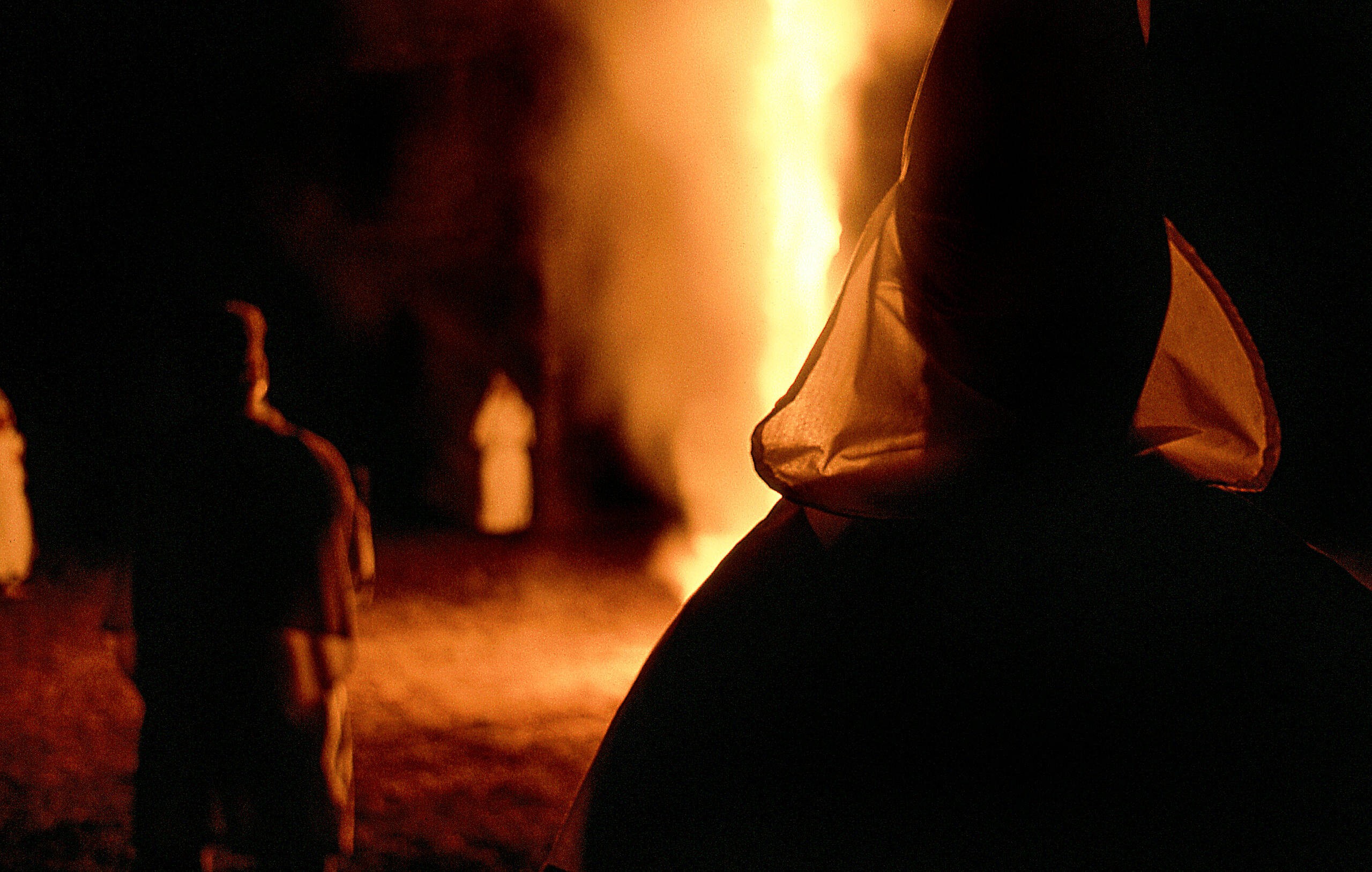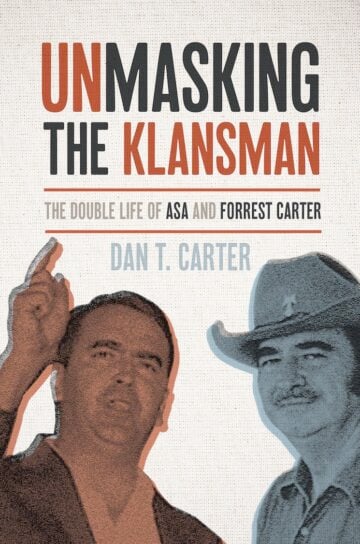
Unmasking the Klansman
A new book reveals the untold story of a Ku Klux Klan member’s literary double life.
A version of this story ran in the November / December 2023 issue.
This story seems hard to believe: One man was an Alabama klansman whose speechwriting made George Wallace a national figure. The other was a best-selling New Age Native American author in Texas. They were also the same man.
Unmasking the Klansman, a new book by historian Dan T. Carter, tells the strange saga of a violent Klan leader, known for his racist and antisemitic radio rants, including then-Alabama Governor George Wallace’s 1962 gubernatorial inauguration speech pledging “segregation forever.” That speechwriter, an unstable alcoholic whose rages scared even the hardest men in Wallace’s inner circle, soon disappeared from Alabama.

A few years later, a tanned stranger in a cowboy hat with a feather in its band strode into the largest bookstore in Abilene, wanting to discuss a novel he’d just written. That novel later became the basis of Clint Eastwood’s classic, The Outlaw Josey Wales. The author followed up on his success with what he claimed was a memoir of growing up Cherokee, The Education of Little Tree. That book became a bestseller and a favorite of New Age readers. It’s still widely read, though it was also eventually attacked as a literary hoax.
Then, before he could complete a planned sequel, this mysterious author’s son beat him to death in a fight in Abilene.
The Alabama man was named Asa Carter. The Texan called himself Forrest Carter. How did one Carter morph into the other?
Author Dan Carter is the historian who outed Carter (no relation) posthumously—just in time to kill a deal for Steven Spielberg to make a film based on The Education of Little Tree—and has now written a biography of Carter’s two halves. Unmasking the Klansman, though, is much more than that. It’s a deep dive into the slow but steady progress of far-right Christian-nationalist thought creeping from the dark corners of our country into acceptability on the edges of mainstream political discourse.
It’s also a personal memoir by Dan Carter, one of the American South’s most distinguished historians.
Dan Carter’s career started with his rediscovery of the case of the Scottsboro Boys, nine Black teenagers who were railroaded into prison on a rape charge that no one ever really believed. The case became infamous in the 1930s, with lawyers sent by the Communist Party and other backers to defend the teenagers. They escaped both a lynch mob and the death penalty, but their prison sentences, though eventually cut short by Alabama lawmakers, ruined their lives.
Their case was basically forgotten until Dan Carter, then a history graduate student, began digging around northeast Alabama, where the so-called crime and trials occurred, collecting oral histories. His first book, Scottsboro: A Tragedy of the American South, won critical acclaim, garnered the Bancroft Prize for history, and brought the case back into the light.
That story also took place close to where Asa Carter grew up.
Dan Carter ran into Asa Carter again when he wrote the definitive biography of George Wallace, longtime governor of Alabama and four-time presidential candidate who came within 10,000 votes, as a third-party candidate, of throwing the 1968 presidential election into the House of Representatives. In his research for another book, The Politics of Rage: George Wallace, the Origins of the New Conservatism, and the Transformation of American Politics, Carter found the addition of klansman Asa Carter as Wallace’s chief campaign writer had been crucial to Wallace’s 1962 gubernatorial victory.
Asa Carter, an alcoholic who flew into frequent rages, was known in Alabama for his extreme racist views, even in the South. But he was also a gifted writer. Only days before Wallace’s gubernatorial inauguration in the winter of 1962, (the race he won infamously by saying he wouldn’t let any other candidate get more extreme on the issue of race), Wallace was desperate to get his victory speech finished. He isolated Carter in a downtown hotel room with “a carton of Pall Mall cigarettes, two bottles of Jack Daniels, and a stack of paper for his Underwood typewriter,” and waited. When Carter emerged after two days, “unshaven, disheveled, and hungover,” he handed Wallace the speech and pointed to one line, saying it would hook everybody. “Segregation today. Segregation tomorrow. Segregation forever.”
Carter’s new biography works on two levels. First, it unravels the mystery of how such an awful man could become a beloved New Age icon, even in death.
Asa Carter, apolitical in his youth, became radicalized while in the Navy during World War II. He progressed from radio announcer work, with increasing audiences, to organizing his own violent Alabama Klan chapters.

He then reappeared in Texas to lead Forrest Carter’s brief but successful career as a novelist. Taking his new name from the founder of the Ku Klux Klan, former Confederate General Nathan Bedford Forrest, he garnered national praise for his writing, while his unstable behavior led Clint Eastwood to tell his staff he never wanted to have any further interactions with the author. In an appearance on national television with Barbara Walters, “Forrest” Carter pulled his cowboy hat down over his face, hoping no one from his “Asa” life would recognize him. As his drinking and health worsened, he visited his son in Abilene, where a fight at a family dinner ended in his death.
The other thread in this new book shows how the fringe, Neo-Nazi racism of the 1930s eventually worked its way into the rhetoric that some accept today.
The author reveals how young Asa Carter, while serving in the South Pacific, was influenced by right-wing media, including Gerald L. K. Smith and his weekly magazine the Cross and the Flag and radio commentators like zealot Harvey Springer and his magazine the Western Voice. To dismiss Asa Carter as an awful racist from a distant past is a mistake, Dan Carter argues. The author compares Asa Carter’s rhetoric, particularly his racial “replacement” views, to Tucker Carlson’s nightly rants and to the rise of groups like the Proud Boys, and the seemingly easy acceptance of far-right rhetoric in the Trump years and even in the U.S. military.
After Carter’s violent death, his family buried him in a small cemetery by the DeArmanville Methodist Church outside of Anniston, Alabama. The small plaque on his tombstone read “Forrest Carter 1926-1979.” A decade later, though, the family felt it safe to erect a new, larger granite headstone that reads “Asa Earl Carter.”
In some ways, the newer, true gravestone reinforces the words of William Faulkner, the South’s most famous novelist, who famously wrote that “The past is never dead. It’s not even past.”
But if that gravestone harkens back into time, the small church nearby, where young Asa once served as the “Superintendent of Religious Education,” provides a different story. It now has a female pastor with mixed-race children. Its Facebook page shows smiling Black faces gracing its small congregation.
Dan Carter finishes this unlikely new book with his own conclusion: “Whatever the future, nothing ever truly remains the same.”



